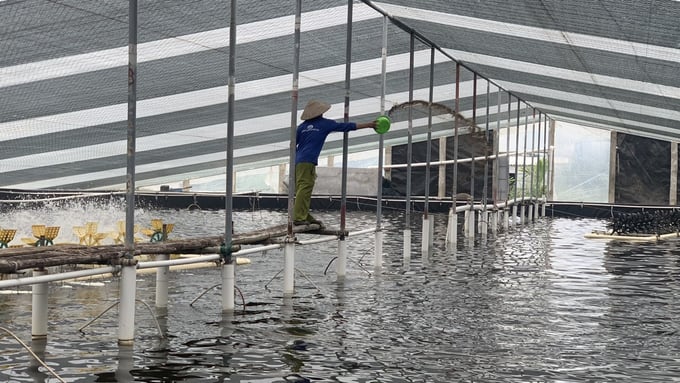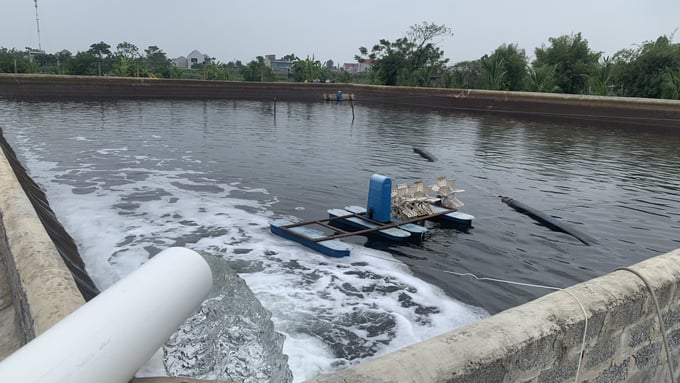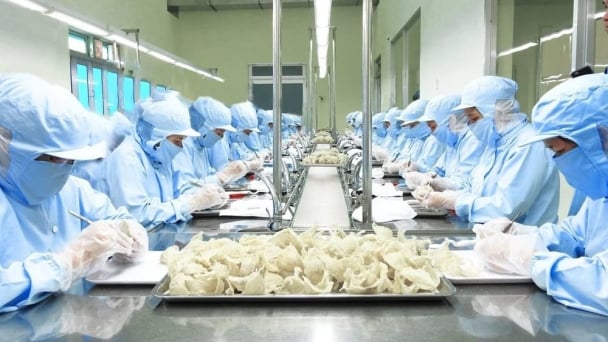May 16, 2025 | 10:25 GMT +7
May 16, 2025 | 10:25 GMT +7
Hotline: 0913.378.918
May 16, 2025 | 10:25 GMT +7
Hotline: 0913.378.918
For a long time, winter shrimp farming in the Northern provinces has been likened to "gambling" with the sky. Although the value is high, harsh weather causes shrimp to underdevelop and cause many diseases. Currently, thanks to high technology, Northern shrimp farmers can overcome difficulties and disadvantages in winter and have a good harvest of winter shrimp.

Deployed since 2016, up to now, the high-tech shrimp farming area of Kim Son district has grown to nearly 65 hectares. Photo: Huy Binh.
In Kim Son district (Ninh Binh), the high-tech shrimp farming model has been deployed since 2016 with an initial scale of only 0.6 hectares. Up to now, the high-tech shrimp farming area of Kim Son district has grown to nearly 65 hectares. The high-tech shrimp farming model with synchronous investment in infrastructure has helped limit diseases, save and reuse water resources, and contribute to environmental protection.
Prominent are intensive high-tech shrimp farming models on floating ponds and super-intensive white-legged shrimp farming in canvas houses. The model applies advanced technological processes and biological filtration with beneficial microbial strains to ensure year-round farming time.
Mr. Duong Viet Luynh, at lot 116, Binh Minh town (Kim Son district), is one of the pioneer households applying high technology to shrimp farming. Mr. Luynh has started intensive shrimp farming on floating ponds using high technology since 2016.
According to Mr. Luynh, initially in Con Thoi area (Kim Son district), people only raised shrimp on earthen ponds, and then some households switched to raising winter shrimp in small canvas houses. Seeing that winter shrimp farming is highly valued, he learned from previous households to build a high-tech shrimp farming model with a systematic greenhouse system.

Thanks to high-tech farming in a greenhouse, Mr. Luynh can actively raise shrimp in the winter. Photo: Huy Binh.
Mr. Luynh's high-tech shrimp farming model is developed toward super-intensive farming with an area of about 25,000 m2, including about 3,000 m2 of water treatment tanks, 16,000 m2 of water tanks, and 6,000 m2 of shrimp farming, producing high-tech products. The average annual output is about 40 - 45 tons.
Mr. Luynh's model does not apply a fixed 3-stage farming process like the usual super-intensive farming model but relies on the weather situation to increase more stages. Among them, water treatment is given the most attention. In particular, thanks to greenhouse farming, a well-invested infrastructure system, and strict farming techniques, Mr. Luynh can now grow shrimp well in the winter.
According to Mr. Luynh, when raising shrimp in floating ponds lined with tarpaulin, the water system supplying the pond must always be proactive and not polluted. Before water is put into the pond, it must be thoroughly treated with potassium permanganate and microbial products in the settling pond system and auxiliary ponds. Indicators such as pH, NH3 or H2S... in water must be controlled and recorded daily.

A corner of the input water treatment area of Mr. Luynh's high-tech white shrimp farming model. Photo: Huy Binh.
According to Mr. Pham Huy Trung, officer of Ninh Binh Fisheries Department, the aquaculture area of the Kim Son alluvial area is currently more than 2,000 hectares. Previously, people mainly raised shrimp extensively. In recent years, intensive shrimp farming models have been developed. By 2022, the intensive farming area reached about 250 hectares, and by 2023, it will reach about 350 hectares. Compared with extensive farming, intensive farming achieves much higher economic efficiency and stable output.
Mr. Trung assessed that intensive and super-intensive shrimp farming models applying high technology like Mr. Luynh's have contributed to changing the face of the fisheries industry in Ninh Binh province. Previously, extensive shrimp farming only yielded 2 tons/ha, but when applying high technology, productivity can reach an average of more than 10 tons/ha and raise 3 crops/year. Shrimp quality is always guaranteed.
To ensure the construction of a systematic, stable farming area and limit epidemics, the local government and Ninh Binh Fisheries Department have guided and developed input and output water treatment processes. For intensive farming models, all are carried out in a closed, circular process, using microbiological technology to ensure a safe farming environment.
In recent years, Ninh Binh province has always focused on developing aquaculture, taking the Kim Son alluvial area as the spearhead. Every year, the Provincial Department of Fisheries coordinates with Kim Son district to carry out propaganda as well as send staff to the facility to support and guide people on techniques, production processes, and prevention of diseases...
Translated by Tuan Huy

(VAN) Japan's efforts to lower the price of rice through the release of its stockpile may finally be making some progress, albeit at a snail's pace.

(VAN) U.S. tariffs are not only a 'shock', but also an opportunity for Vietnamese businesses to renew their mindset toward comprehensive development.

(VAN) As Bac Giang lychee enters the harvest season, Minister Do Duc Duy expects that the fruit will contribute greatly to agricultural exports due to standardized production and deep processing.

(VAN) Consumers have shown a preference for free-range eggs, but those farming systems are more vulnerable to biosecurity risks like bird flu.
/2025/05/09/5701-1-184335_301.jpg)
(VAN) Vietnam’s eel exports nearly doubled thanks to a mud-free farming model, opening up new prospects while still facing numerous barriers related to international standards.

(VAN) Minister Do Duc Duy warned that if production is not professionalized and supply chains are not transparent, the U.S. market could become a growth bottleneck.

(VAN) Delegating surveillance responsibilities to local authorities is a cost-saving and efficiency-boosting measure that removes a key bottleneck for enterprises, according to Director General Duong Tat Thang.